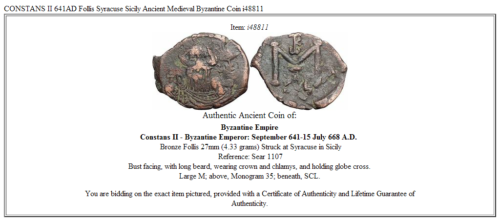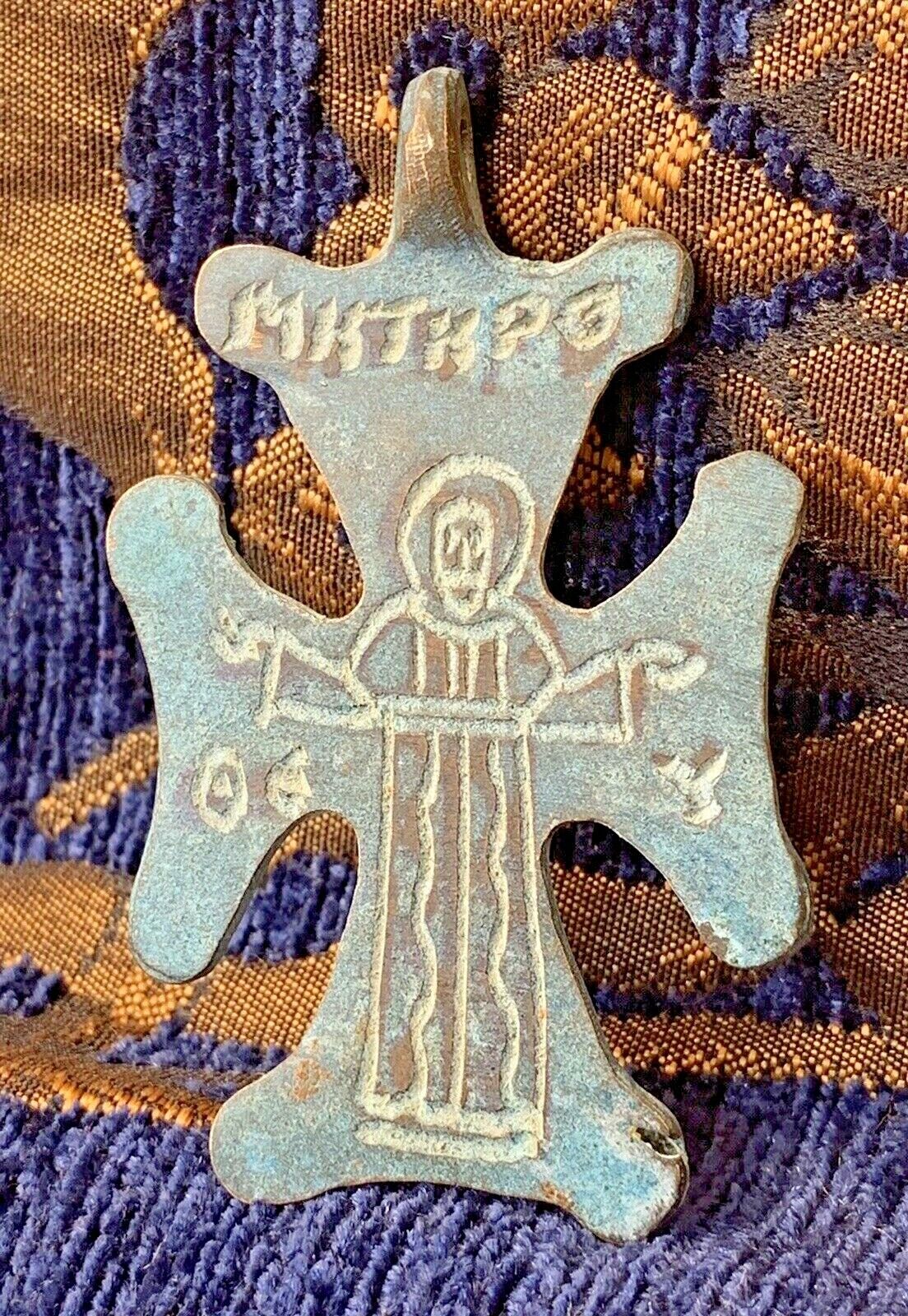-40%
CONSTANS II 641AD Follis Syracuse Sicily Ancient Medieval Byzantine Coin i48811
$ 106.91
- Description
- Size Guide
Description
Item:i48811
Authentic Ancient Coin of:
Byzantine Empire
Constans II - Byzantine Emperor: September 641-15 July 668 A.D.
Bronze Follis 27mm (4.33 grams) Struck at Syracuse in Sicily
Reference: Sear 1107
Bust facing, with long beard, wearing crown and chlamys, and holding globe cross.
Large M; above, Monogram 35; beneath, SCL.
You are bidding on the exact item pictured, provided with a Certificate of Authenticity and Lifetime Guarantee of Authenticity.
Constans II
(
Greek
:
Κώνστας Β',
Kōnstas II
), also called "Constantine the Bearded" (
Kōnstantinos Pogonatos
), (
November 7
,
630
–
September 15
,
668
) was
Byzantine emperor
from 641 to 668. He also was the last emperor to become consul in 642, becoming the last
Roman consul
in history.
Constans is a diminutive nickname given to the emperor, who had been baptized Herakleios and reigned officially as Constantine. The nickname established itself in Byzantine texts, and has become standard in modern historiography. //
Biography
Constans was the son of
Constantine III
and
Gregoria
. Due to the rumours that
Heraklonas
and
Martina
had poisoned Constantine III he was named co-emperor in 641. Later that same year his uncle was deposed and Constans II was left as sole emperor.
Constans owed his throne to a popular reaction against his uncle and to the protection of the soldiers led by the general Valentinus. Although the precocious emperor addressed the senate with a speech blaming Heraklonas and Martina for eliminating his father, he reigned under a regency of senators led by
Patriarch Paul II of Constantinople
. In 644 Valentinus attempted to seize power for himself but failed.
Under Constans, the Byzantines completely withdrew from
Egypt
in 642, and
Caliph Uthman
launched numerous attacks on the islands of the
Mediterranean Sea
and
Aegean Sea
. A Byzantine fleet under the admiral Manuel occupied
Alexandria
again in 645, but after a Muslim victory the following year this had to be abandoned. The situation was complicated by the violent opposition to
Monothelitism
by the clergy in the west, and the related rebellion of the Exarch of
Carthage
, Gregory. The latter fell in battle against the army of Caliph Uthman and the region remained a vassal state under
Caliphate
, until the civil war broke out and the imperial rule was again restored.
Constans attempted to steer a middle line in the church dispute between Orthodoxy and Monothelitism, by refusing to persecute either and prohibiting further discussion of the natures of
Jesus
Christ
by decree in 648. Naturally, this live-and-let-live compromise satisfied few passionate participants in the dispute.
Meanwhile, the
Caliphate
advance continued unabated. In 647 they had entered into
Armenia
and
Cappadocia
, and sacked
Caesarea Mazaca
. In 648 the Arabs raided into
Phrygia
and in 649 launched their first maritime expedition against
Crete
. A major Arab offensive into
Cilicia
and
Isauria
in 650–651 forced the emperor to enter into negotiations with
Caliph Uthman
's governor of
Syria
,
Muawiyah
. The truce that followed allowed a short respite, and made it possible for Constans to hold on to the western portions of Armenia.
In 654, however,
Muawiyah
renewed his raids by sea, and plundered
Rhodes
. Constans led a fleet to attack the
Muslims
at Phoinike (off
Lycia
) in 655 at the
Battle of the Masts
, but he was defeated: 500 Byzantine ships were destroyed in the battle, and the emperor himself risked to be killed. Before the battle, chronicler
Theophanes the Confessor
says, the emperor dreamt to be at Thessalonika, this dream predicted his defeat against the Arabs because the word
Thessalonika
is similar to the sentence "thes allo niken", that means "gave victory to another (the enemy)".
[3]
Caliph
Uthman
was preparing to attack
Constantinople
, but did not carry out the plan when civil war between the future
Sunni
and
Shi'a
factions broke out among them in 656.
With the eastern frontier under less pressure, in 658 Constans defeated the
Slavs
in the
Balkans
, temporarily reasserting some notion of Byzantine rule over them. In 659 he campaigned far to the east, taking advantage of a rebellion against the Caliphate in
Media
. The same year he concluded peace with the Arabs.
Now Constans could turn to church matters once again.
Pope Martin I
had condemned both Monothelitism and Constans' attempt to halt debates over it (the
Type of Constans
) in the
Lateran Council of 649
. Now the emperor ordered his Exarch of
Ravenna
to arrest the Pope. One Exarch excused himself from this task, but his successor carried it out in 653. The Pope was brought to Constantinople and condemned as a criminal, ultimately being exiled to
Cherson
, where he died in 655.
Constans grew increasingly fearful that his younger brother, Theodosius, could oust him from the throne: he therefore obliged him first to take holy orders, and later had Theodosius killed in 660. Constans' sons Constantine, Heraclius, and Tiberius had been associated on the throne since the 650s. However, having attracted the hatred of citizens of Constantinople, Constans decided to leave the capital and to move to
Syracuse
in
Sicily
.
From here, in 661, he launched an assault against the
Lombard
Duchy of Benevento
, which then occupied most of
Southern Italy
. Taking advantage of the fact that Lombard king
Grimoald I of Benevento
was engaged against Frankish forces from
Neustria
, Constans II disembarked at
Taranto
and besieged
Lucera
and
Benevento
. However, the latter resisted and Constans withdrew to
Naples
. During the travel from Benevento to Naples, Constans II was defeated by Mitolas, Count of Capua, near Pugna. Constans ordered Saburrus, the commander of his army, to attack again the Lombards but he was defeated by the Beneventani at
Forino
, between
Avellino
and
Salerno
.
In 663 Constans visited
Rome
for 12 days—no emperor having set foot in Rome for two centuries—and was received with great honor by
Pope Vitalian
(657–672). Although on friendly terms with Vitalian, he stripped buildings, including the
Pantheon
, of their ornaments and bronze to be carried back to Constantinople, and declared the
Pope of Rome
to have no jurisdiction over the Archbishop of Ravenna, since that city was the seat of the
exarch
, his immediate representative.
His subsequent moves in
Calabria
and
Sardinia
were marked by further strippings and request of tributes that enraged his Italian subjects. Rumours that he was going to move the capital of the empire to Syracuse were probably fatal for Constans. On
September 15
,
668
he was assassinated in his bath by his
chamberlain
. His son Constantine succeeded him as
Constantine IV
, a brief usurpation in Sicily by
Mezezius
being quickly suppressed by the new emperor.
Family
By his wife
Fausta
, a daughter of the patrician Valentinus, Constans II had three sons:
Constantine IV
, who succeeded as emperor
Heraclius, co-emperor from 659 to 681
Tiberius, co-emperor from 659 to 681
Frequently Asked Questions
How long until my order is shipped?
Depending on the volume of sales, it may take up to 5 business days for shipment of your order after the receipt of payment.
How will I know when the order was shipped?
After your order has shipped, you will be left positive feedback, and that date should be used as a basis of estimating an arrival date.
After you shipped the order, how long will the mail take?
USPS First Class mail takes about 3-5 business days to arrive in the U.S., international shipping times cannot be estimated as they vary from country to country. I am not responsible for any USPS delivery delays, especially for an international package.
What is a certificate of authenticity and what guarantees do you give that the item is authentic?
Each of the items sold here, is provided with a Certificate of Authenticity, and a Lifetime Guarantee of Authenticity, issued by a world-renowned numismatic and antique expert that has identified over 10000 ancient coins and has provided them with the same guarantee. You will be quite happy with what you get with the COA; a professional presentation of the coin, with all of the relevant information and a picture of the coin you saw in the listing.
Compared to other certification companies, the certificate of authenticity is a -50 value. So buy a coin today and own a piece of history, guaranteed.
Is there a money back guarantee?
I offer a 30 day unconditional money back guarantee. I stand behind my coins and would be willing to exchange your order for either store credit towards other coins, or refund, minus shipping expenses, within 30 days from the receipt of your order. My goal is to have the returning customers for a lifetime, and I am so sure in my coins, their authenticity, numismatic value and beauty, I can offer such a guarantee.
Is there a number I can call you with questions about my order?
You can contact me directly via ask seller a question and request my telephone number, or go to my About Me Page to get my contact information only in regards to items purchased on eBay.
When should I leave feedback?
Once you receive your order, please leave a positive. Please don't leave any negative feedbacks, as it happens many times that people rush to leave feedback before letting sufficient time for the order to arrive. Also, if you sent an email, make sure to check for my reply in your messages before claiming that you didn't receive a response. The matter of fact is that any issues can be resolved, as reputation is most important to me. My goal is to provide superior products and quality of service.











